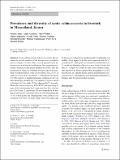Prevalence and diversity of cystic echinococcosis in livestock in Maasailand, Kenya
View/
Publication Date
8/23/2012Type
Article, Journalviews
downloads
Metadata
Show full item recordCitation
Parasitol Res (2012) 111:2289–2294 DOI 10.1007/s00436-012-3082-8
Abstract/
Abstract Cystic echinococcosis (CE) is a zoonotic disease caused by several members of the Echinococcus granulosus species complex. In East Africa, several species/strains are known to occur in livestock and humans, but host preferences, relative frequencies and spatial distribution of these taxa are poorly known. Here, we contribute livestock data for Maasailand of southern Kenya. Total CE prevalence was 25.8 % in cattle (151/587), 16.5 % in sheep (71/430) and 10.8 % in goats (21/194), which is a significant increase compared to surveys done about three decades ago. The majority of cysts occurred in the liver (56 % in cattle, 70 % in sheep and 65 % in goats). Molecular characterization by PCR–RFLP and sequencing of parts of the mitochondrial nad-1 gene was done for a subsample of 285 cysts. E. granulosus G1 was dominant in all host species (200 of 201 cysts from cattle, 68 of 69 from sheep and 11 of 15 from goats); the remaining taxa were Echinococcus canadensis G6 (one cyst from sheep, four from goats) and Echinococcus ortleppi (one cyst from cattle). Considering cyst fertility, sheep appear to be the most important hosts for E. granulosus G1, while goats were found to be suitable hosts for E. canadensis G6 (three of four cysts were fertile). For the first time, E. ortleppi was found in cattle from southern Kenya. Our data show an intense and possibly increasing level of CE transmission in southern Kenya, and the predominance of E. granulosus G1, which appears to be particularly pathogenic to humans, calls for urgent control measures.
Subject/
Echinococcus granulosus; East Africa; Maasailand; cysts; Abattoirs; Livestock; Kenya
Publisher
SpringerCollections
- General - GEN [367]

